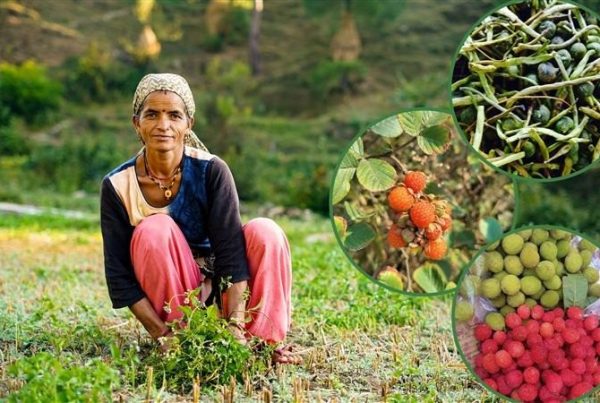“We abuse land because we regard it as a commodity belonging to us. When we see land as a community to which we belong, we may begin to use it with love and respect.”
This profound quote by American ecologist and environmentalist Aldo Leopold sets the stage for a critical analysis of our relationship with land, especially in the context of widespread desertification and degradation. This World Environment Day, as humanity grapples with the consequences of such large-scale environmental degradation, the issue has never been more urgent.
Land degradation, desertification, and drought (DLDD) are closely related environmental issues, where degradation refers to the decline in land quality caused by various anthropogenic activities like deforestation, overgrazing, and poor agricultural practices. Accelerating at an alarming pace, land degradation is significantly reducing productivity of croplands and rangelands worldwide. As per the World Atlas of Desertification (2018), over 75% of Earth’s land area is already degraded, and if this continues, by 2050 this will increase to 90%.[1] Currently, 3.2 billion people are affected by land degradation, and the impacts of these are felt particularly by rural communities, smallholder farmers, and the very poor.[2]
When we think of desertification, images of sand dunes being swept away by gusty winds in desert landscapes such as the Thar or Gobi come to mind. However, desertification is a much broader phenomenon, referring to a decline in the biological productivity of land due to a variety of natural and human induced causes including deforestation, overgrazing, unsustainable agricultural practices, excessive flooding and overexploitation of resources. Desertification not only contributes to the expansion of desert systems but also destroys vital dryland ecosystems, including the deserts themselves, and drylands, and scrublands. Presently, it threatens over 2 billion people worldwide who depend on land for sustenance. Moreover, desertification contributes to internal displacement and international migration of people. It is estimated that if the rate of desertification remains unchecked, 50 million people will be displaced by 2030 due to it.[3] While this process has occurred throughout history, its pace has increased significantly, now occurring 30 to 35 times faster than historical rates.[4] Between 2015 to 2019, globally approximately 100 million hectares of fertile land was lost to land degradation, an area equivalent to twice the size of Greenland.[5]
Drought – defined as a prolonged period of low to no rainfall is becoming a terrifying frequent reality. It speeds up desertification creating a vicious cycle of land degradation. From 1970 to 2019, droughts have led to an estimated 650,000 deaths worldwide, and in just the last two decades over 1.4 billion people were affected by it.[6] As per the United Nations Convention to Combat Desertification (UNCCD), by 2030, an estimated 700 million people will be at risk of being displaced by drought. Over the next two decades between 4.8 to 5.7 billion people are estimated to live in areas that are water-scarce for at least one month each year, a significant jump from the estimated 3.6 billion in 2018.[7],[8] Destruction at this scale has tremendous consequences in terms of reduced agricultural productivity, biodiversity loss, and increased vulnerability of ecosystems and people dependent on them. The consequences extend far beyond local ecosystems, causing widespread socio-economic implications such as food insecurity, water scarcity, and increased poverty. This emphasizes the urgent need for comprehensive strategies to protect communities and ecosystems across the world.
Amidst these escalating challenges, land restoration through Nature-based Solutions emerges as a beacon of hope. The United Nations Decade on Ecosystem Restoration (2021-30) aims to prevent, halt, and reverse the degradation of ecosystems worldwide. This will not only have environmental benefits, but the potential economic returns will be significant – for every dollar invested in land management and restoration, there can be up to $30 worth of benefits received from ecosystem services such as clean water, fertile soil, and climate resilience.[9] In the local context, the scenario presents a mix of challenges and potential innovative solutions. India faces severe land degradation, with about 32% of our land under degradation and 25% undergoing desertification.[10] This has significant implications for a country where agriculture is a primary livelihood for a large portion of the population. The country has committed to restoring 26 million hectares of land by 2030 to achieve its commitment of land degradation neutrality. This would further contribute to India’s commitment of achieving an additional carbon sink of 2.5 to 3 billion tonnes of carbon dioxide equivalent by 2030.[11]
However, achieving large-scale restoration requires overcoming several barriers. The UN Decade has identified six key obstacles: limited societal awareness of the negative effects of ecosystem degradation and the benefits of restoration; insufficient financing; lack of supportive legislation and policies; limited technical knowledge and capacity; and inadequate investment in long-term research.[12] Addressing these intertwined challenges requires a multifaceted approach.
Envisioning land as a community has profound implications for all of us. For urban dwellers, this perspective might translate into greener cities, with urban agriculture and community gardens improving mental and physical health. It can inspire lifestyle changes that reduce our ecological footprint. This involves supporting local and sustainable food sources, reducing waste, and participating in local conservation efforts; recognizing that our daily choices have a direct impact on the health of our environment. For policymakers, it means developing strong frameworks that prioritize land health, promote sustainable land use, and protect natural habitats from degradation.
Embracing this vision requires innovative solutions that integrate technology with traditional knowledge. Imagine smart agriculture practices that use data to optimize water usage, reduce chemical inputs, and increase crop yields sustainably. Visualize a world where communities actively participate in reforestation projects, not just planting trees but nurturing ecosystems back to health and creating wildlife corridors that support biodiversity.
Implementing Leopold’s philosophy, as we move forward in life, offers us a chance to mend our fractured relationship with nature. By acknowledging land not merely as a resource to be exploited but as a living entity that supports and sustains all forms of life; it encourages us to see ourselves as stewards responsible for its health and vitality. This shift in perspective compels us to adopt more sustainable and respectful practices, nurturing a much deeper connection with our planet while facilitating resilient communities that thrive in harmony with the environment.
[2] https://www.thegef.org/what-we-do/topics/land-degradation
[3] https://www.unisdr.org/files/1794_VL102205.pdf
[6] https://www.unccd.int/sites/default/files/2022-05/Drought%20in%20Numbers.pdf
[7]https://www.unccd.int/sites/default/files/2023-12/Global%20drought%20snapshot%202023.pdf
[12] Ecosystem restoration: India holds great promise during the UN Decade (mongabay.com)






